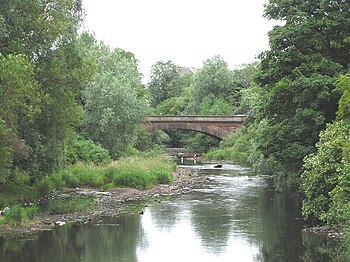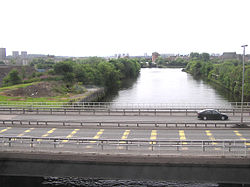Difference between revisions of "River Kelvin"
m |
|||
| (One intermediate revision by one other user not shown) | |||
| Line 1: | Line 1: | ||
[[File:Wfm kelvingrove park.jpg|right|thumb|350px|The Kelvin flowing through Kelvingrove Park]] | [[File:Wfm kelvingrove park.jpg|right|thumb|350px|The Kelvin flowing through Kelvingrove Park]] | ||
[[File:Wfm kelvin clyde.jpg|right|thumb|250px|The Kelvin flowing under the Clydeside Expressway and into the River Clyde]] | [[File:Wfm kelvin clyde.jpg|right|thumb|250px|The Kelvin flowing under the Clydeside Expressway and into the River Clyde]] | ||
| − | The '''River Kelvin''' is a | + | The '''River Kelvin''' is a right-bank tributary of the [[River Clyde]]; entering the tidal Clyde in [[Glasgow]]. |
| − | The Kelvin rises on watershed between the east and west coasts on the moor south east of the village of [[Banton]], east of [[Kilsyth]]. It is almost 22 miles long from source to the Clyde | + | The Kelvin rises on watershed between the east and west coasts on the moor south east of the village of [[Banton]], east of [[Kilsyth]]. It is almost 22 miles long from source to the Clyde. From Kilsyth to [[Kirkintilloch]] it forms the border between [[Stirlingshire]] and the detached part of [[Dunbartonshire]]; from the Park Burn to Killermont it forms the border between Stirlingshire and [[Lanarkshire]]; and from there to Kelvindale it forms the border between Dunbartonshire proper and Lanarkshire. |
From its spring, the infant Kelvin initially flows south to [[Dullatur Bog]] where it falls into a man made trench and takes a ninety degree turn flowing west along the northern boundary of the bog parallel with the [[Forth & Clyde Canal]]. Its first important (and considerably larger) confluence is with the Chantyclear Burn which originates from the ridge of [[Dullatur]]. The Kelvin then continues its westward flow being joined by the often depleted (due to water being diverted to the canal) Shawend Burn to the west of Craigmarloch bridge. | From its spring, the infant Kelvin initially flows south to [[Dullatur Bog]] where it falls into a man made trench and takes a ninety degree turn flowing west along the northern boundary of the bog parallel with the [[Forth & Clyde Canal]]. Its first important (and considerably larger) confluence is with the Chantyclear Burn which originates from the ridge of [[Dullatur]]. The Kelvin then continues its westward flow being joined by the often depleted (due to water being diverted to the canal) Shawend Burn to the west of Craigmarloch bridge. | ||
| − | The next important tributary is the Garrel at a point south-east of [[Kilsyth]] south of Dumbreck Marsh. The Kelvin then passes through the large | + | The next important tributary is the Garrel at a point south-east of [[Kilsyth]] south of Dumbreck Marsh. The Kelvin then passes through the large floodplain north of [[Twechar]] where is fed by the Dock Water, Queenzie Burn, the Cast Burn and the Board Burn before reaching [[Kirkintilloch]] at its confluence with the more substantial waters of the [[Glazert]] and [[Luggie]], it then flows past [[Torrance]], meanders through [[Balmore]] Haughs, to the south of Bardowie where it joins the [[Allander Water]] after which it takes a south-westerly direction towards [[Maryhill]], [[Hillhead]], through [[Kelvingrove Park]] before falling into the [[River Clyde]] at Yorkhill Basin in the city of [[Glasgow]]. |
==Wildlife== | ==Wildlife== | ||
| Line 22: | Line 22: | ||
==Trivia== | ==Trivia== | ||
| − | The famous physicist William Thomson, 1st Baron Kelvin was named Baron Kelvin in honour of his achievements, named after the river that flowed past his university. Consequently it indirectly gives its name to the SI unit of temperature, named after Lord Kelvin. | + | The famous physicist William Thomson, 1st Baron Kelvin was named Baron Kelvin in honour of his achievements, named after the river that flowed past his university. Consequently, it indirectly gives its name to the SI unit of temperature, named after Lord Kelvin. |
==Outside links== | ==Outside links== | ||
| Line 34: | Line 34: | ||
{{DEFAULTSORT:Kelvin}} | {{DEFAULTSORT:Kelvin}} | ||
| − | [[Category:Rivers of Lanarkshire]] [[Category:Tributaries of the River Clyde]] | + | [[Category:Rivers of Dunbartonshire]] |
| + | [[Category:Rivers of Lanarkshire]] | ||
| + | [[Category:Rivers of Stirlingshire]] | ||
| + | [[Category:Tributaries of the River Clyde]] | ||
Latest revision as of 08:23, 1 April 2016
The River Kelvin is a right-bank tributary of the River Clyde; entering the tidal Clyde in Glasgow.
The Kelvin rises on watershed between the east and west coasts on the moor south east of the village of Banton, east of Kilsyth. It is almost 22 miles long from source to the Clyde. From Kilsyth to Kirkintilloch it forms the border between Stirlingshire and the detached part of Dunbartonshire; from the Park Burn to Killermont it forms the border between Stirlingshire and Lanarkshire; and from there to Kelvindale it forms the border between Dunbartonshire proper and Lanarkshire.
From its spring, the infant Kelvin initially flows south to Dullatur Bog where it falls into a man made trench and takes a ninety degree turn flowing west along the northern boundary of the bog parallel with the Forth & Clyde Canal. Its first important (and considerably larger) confluence is with the Chantyclear Burn which originates from the ridge of Dullatur. The Kelvin then continues its westward flow being joined by the often depleted (due to water being diverted to the canal) Shawend Burn to the west of Craigmarloch bridge.
The next important tributary is the Garrel at a point south-east of Kilsyth south of Dumbreck Marsh. The Kelvin then passes through the large floodplain north of Twechar where is fed by the Dock Water, Queenzie Burn, the Cast Burn and the Board Burn before reaching Kirkintilloch at its confluence with the more substantial waters of the Glazert and Luggie, it then flows past Torrance, meanders through Balmore Haughs, to the south of Bardowie where it joins the Allander Water after which it takes a south-westerly direction towards Maryhill, Hillhead, through Kelvingrove Park before falling into the River Clyde at Yorkhill Basin in the city of Glasgow.
Wildlife
Wildlife along the River Kelvin corridor includes the grey squirrel, magpie, grey heron, cormorant, blue tit, great tit, chaffinch, snipe, great spotted woodpecker, blackbird, redwing, carrion crow, kingfisher, mallard, goosander, roe deer, red fox, otter, water vole, mink and brown rat.
Successive attempts at improving the quality of the water have been rewarded by the return of salmon. The river has always been home to brown trout and both species can be fished by obtaining the relevant permits.[1]
Bridges over the Kelvin
The Kelvin is bridged at several points throughout Glasgow. Most notable is the Great Western Bridge on Great Western Road in the city's West End. Below this bridge is an underground station that bears the name Kelvinbridge, a name commonly attached to the area. Other bridges include Partick Bridge on Dumbarton Road, the bridge at Queen Margaret Drive and a number in the grounds of Kelvingrove Park.
Also notable is the Kelvin Aqueduct which carries the Forth and Clyde Canal over the river. It was Britain's largest when it was opened. The river is used as an overflow for the canal.
Trivia
The famous physicist William Thomson, 1st Baron Kelvin was named Baron Kelvin in honour of his achievements, named after the river that flowed past his university. Consequently, it indirectly gives its name to the SI unit of temperature, named after Lord Kelvin.
Outside links
- Friends of the River Kelvin
- River Kelvin Angling Association
- Kelvin Walkway - Glasgow West End - Illustrated guide to riverside walk
References
- ↑ "Urban Fly Fishing on the Kelvin". http://theriverkelvin.co.uk/theclub.htm. Retrieved 2008-04-26.
- History of Banton; William Gracie, 1995 pub. Stratkelvin district council. (Kilsyth Library, local studies)

